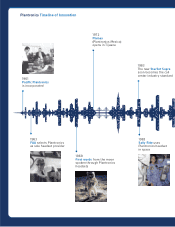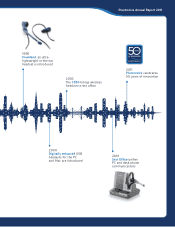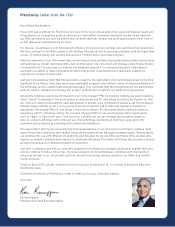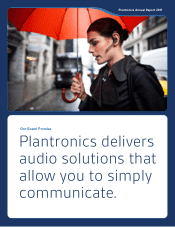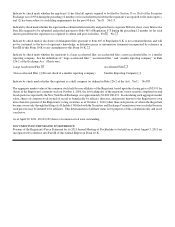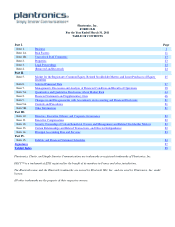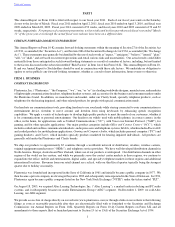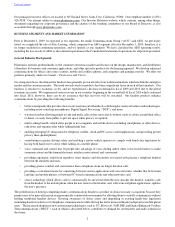Plantronics 2011 Annual Report Download - page 11
Download and view the complete annual report
Please find page 11 of the 2011 Plantronics annual report below. You can navigate through the pages in the report by either clicking on the pages listed below, or by using the keyword search tool below to find specific information within the annual report.
Our principal executive offices are located at 345 Encinal Street, Santa Cruz, California, 95060. Our telephone number is (831)
426-5858. Our internet address is www.plantronics.com. Our Investor Relations website, which contains, among other things,
documents regarding our corporate governance and the charters of the standing committees of our Board of Directors, is also
accessible through www.plantronics.com.
BUSINESS SEGMENTS AND MARKET INFORMATION
Prior to December 1, 2009, we operated as two segments, the Audio Communications Group (“ACG”) and AEG. As previously
noted, we completed the sale of Altec Lansing, which comprised our AEG segment, effective December 1, 2009; therefore, it is
no longer included in continuing operations, and we operate as one segment. We have classified the AEG operating results,
including the loss on sale of AEG, as discontinued operations in the Consolidated statement of operations for all periods presented.
General Industry Background
Plantronics operates predominantly in the consumer electronics market and focuses on the design, manufacture, and distribution
of headsets for business and consumer applications, and other specialty products for the hearing impaired. We develop enhanced
communications for offices and contact centers, mobile and cordless phones, and computers and gaming consoles. We offer our
products primarily under two brands – Plantronics and Clarity.
On a long-term basis, the demand for headsets has generally grown in both of our traditional markets which include the enterprise
market and the consumer market. The trend towards wireless products has been a significant factor in each of these markets. Our
business is sensitive to economic cycles, and we experienced a decrease in demand in fiscal 2009 and 2010 due to the global
economic recession. We experienced some recovery in our revenues beginning in the second half of fiscal 2010 which continued
into fiscal 2011; however, there can be no assurance that this recovery will be sustained. Our headset products enhance
communications by providing the following benefits:
• better sound quality that provides clearer conversations on both ends of a call through a variety of features and technologies,
including noise-canceling microphones, Digital Signal Processing (“DSP”), and more;
• wireless freedom allowing people to take and make calls as they move freely without cords or cables around their office
or home, or easily from public to private space when privacy is required;
• multi-tasking benefits which allow people to use computers and mobile devices including smartphones or other devices,
take notes and organize files while talking hands free;
• enabling emerging UC integration for telephony, mobile, cloud and PC across varied applications, and providing greater
privacy than speakerphones;
• contributing to greater driving safety and enabling a motor vehicle operator to comply with hands-free legislation by
having both hands free to drive while talking on a mobile phone;
• voice command and control that let people take advantage of voice dialing and/or other voice-based features to make
communications and the human/electronic interface more natural and convenient;
• providing ergonomic relief from repetitive stress injuries and discomfort associated with placing a telephone handset
between the shoulder and neck;
• providing greater comfort and convenience than a telephone alone on longer duration calls;
• providing a convenient means for connecting between various applications and voice networks, whether that be between
land line and mobile phones, or between PC-based communications and other networks; and
• sensor technology which allows calls to automatically be answered when the user attaches the headset, transfers calls
from the headset to the mobile phone when the user removes the headset, and, with some softphone applications, updates
the user's presence.
The proliferation of desktop computing makes communications headsets a product of choice in many occupations because they
permit users to be more efficient in an ergonomically comfortable environment by allowing them to verbally communicate without
holding traditional handset devices. Growing awareness of driver safety and impending or existing hands-free legislation
mandating hands-free devices for telephonic communications while driving has led to increased headset adoption for mobile phone
users. The increased adoption of new and existing technologies, such as UC, Bluetooth, VoIP, DSP, and Digital Enhanced Cordless
Telecommunications (“DECT”), each of which is described below, contributes to demand for our headsets and audio solutions in
the future:
Table of Contents
2



